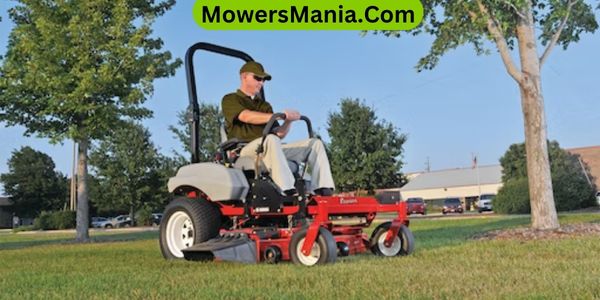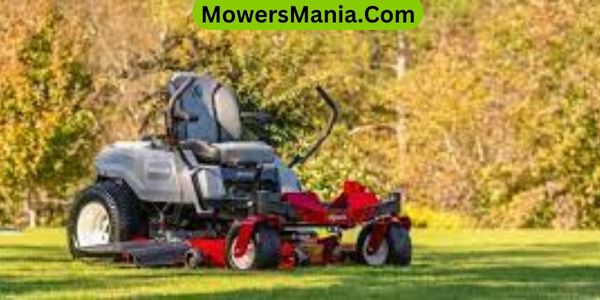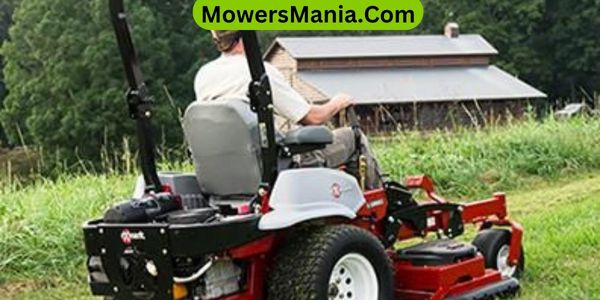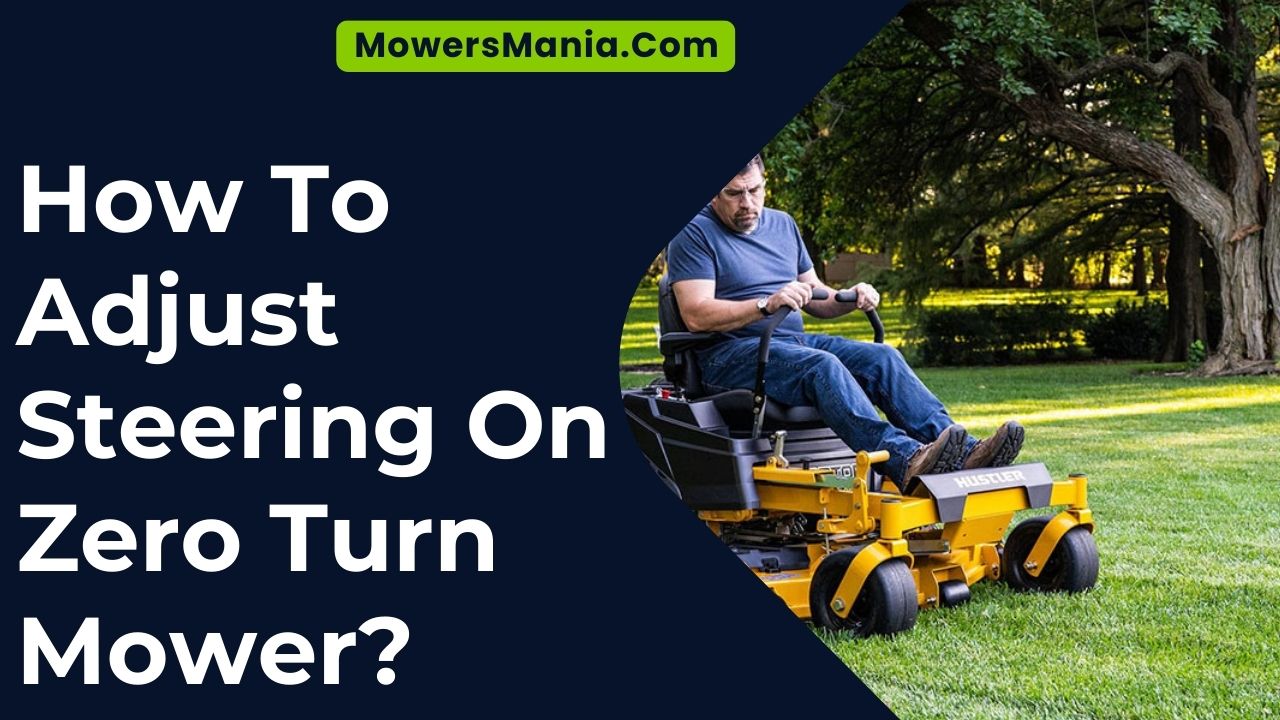If your zero turn mower feels hard to steer or pulls to one side, you may need to adjust the steering. This guide will show you how to make the necessary adjustments to get your mower steering smoothly again.
By understanding the steering components and following a few simple steps, you can easily fine-tune the steering tension and sensitivity.

With some basic adjustments, you’ll have your zero turn mower gliding effortlessly around your yard in no time.
Understanding Zero Turn Mower Steering Components
To understand the steering components of your zero turn mower, you should first familiarize yourself with the main parts that make up the steering system.
The key components include the steering levers or bars, hydraulic pumps, wheel motors, and the linkage that connects everything.
The steering levers are the primary control for maneuvering the mower. As you move the levers forward or backward, it adjusts the speed and direction of the mower.
The hydraulic pumps are powered by the engine and generate hydraulic pressure, which is then transmitted to the wheel motors. These wheel motors drive the individual wheels of the mower and allow it to turn in place.
The linkage, consisting of various rods and connectors, transfers the motion from the levers to the hydraulic pumps and wheel motors.
Understanding these components is crucial for maintaining and adjusting the steering of your zero turn mower.
By familiarizing yourself with how these parts work together, you can better troubleshoot any steering issues and perform regular maintenance to keep the steering system in optimal condition.
Identifying Signs of Steering Issues
If you notice uneven turning or drifting while operating your zero turn mower, it could be a sign of steering issues.
Additionally, if you feel a vibration in the steering wheel, it may indicate a problem with the steering components.
Difficulty in maneuvering the mower, especially when making sharp turns, is another common sign of steering issues that shouldn’t be ignored.
Uneven Turning or Drifting
First, check for signs of uneven turning or drifting when operating your zero turn mower. Uneven turning occurs when one side of the mower turns more sharply than the other, causing the mower to veer to one side.
This may indicate steering issues such as unequal hydraulic pressure to the drive motors or an imbalance in the steering control arms.
Similarly, drifting happens when the mower consistently pulls to one side without input from the controls.
It can be a sign of tire pressure inconsistencies, worn-out wheel bearings, or misaligned steering levers. Identifying these signs is crucial for diagnosing steering problems and taking corrective measures.
Regularly inspect your zero turn mower for these issues, as prompt attention can prevent further damage and ensure smooth, precise steering.
Steering Wheel Vibration
Experiencing steering wheel vibration is a clear indicator of potential steering issues on your zero turn mower.
When you feel a noticeable vibration in the steering wheel while operating the mower, it’s crucial to address it promptly to prevent further damage.
Steering wheel vibration can be a sign of misaligned wheels, worn-out steering components, or even an unbalanced cutting deck.
Ignoring these signs can lead to more severe steering problems and compromise the overall performance of your mower.
To identify the root cause of the vibration, carefully inspect the steering system, wheel alignment, and cutting deck balance.
Regular maintenance, such as checking tire pressure and ensuring proper lubrication of steering components, can help prevent steering wheel vibration and maintain smooth operation of your zero turn mower.
Difficulty in Maneuvering
When maneuvering your zero turn mower, if you encounter resistance or difficulty in turning, it could indicate potential steering issues that require attention.
Difficulty in maneuvering may manifest as the mower feeling sluggish or unresponsive when attempting to turn, especially in one direction. You may also notice uneven or jerky movements when trying to navigate around obstacles.
Another sign of steering issues is if one wheel seems to turn more slowly than the other, causing the mower to veer off course.
Additionally, excessive play or looseness in the steering controls can indicate a need for adjustment or repair.
Identifying these signs early can help prevent further damage and ensure safe and efficient operation of your zero turn mower.
Adjusting the Steering Lever Tension

Once you have identified the steering lever tension adjustment bolt, you can begin the process of making the necessary adjustments for a smoother and more responsive steering experience on your zero turn mower.
To adjust the steering lever tension, start by locating the adjustment bolt, which is typically located near the base of the steering lever.
Using the appropriate tools, such as a wrench or socket set, loosen the adjustment bolt to release the tension on the steering lever.
Once the bolt is loosened, you can adjust the tension to your preference. Turning the bolt clockwise will increase tension, making the steering lever firmer, while turning it counterclockwise will decrease tension, allowing for easier steering movement. It’s important to find the right balance that suits your comfort and maneuverability needs.
After making the necessary adjustments, securely tighten the adjustment bolt to ensure the tension is locked in place.
Testing the steering lever afterwards will help you determine if further adjustments are needed to achieve the desired steering responsiveness.
Adjusting the Steering Sensitivity
To adjust the steering sensitivity on your zero turn mower, you can start by checking the tension of the steering lever and making any necessary adjustments.
Next, examine the control arm and ensure it’s properly adjusted to achieve the desired steering response.
Steering Lever Tension
To adjust the steering sensitivity on your zero turn mower, you’ll need to modify the tension of the steering lever.
Start by locating the adjustment nut on the steering lever. Use a wrench to loosen the nut, allowing you to adjust the tension.
Turning the nut clockwise will increase the tension, making the steering more sensitive. Conversely, turning it counterclockwise will decrease the tension, making the steering less sensitive.
Test the steering after making adjustments to ensure it feels comfortable and responsive to your movements. It’s important to find the right balance of tension that suits your preferences and provides optimal control.
Regularly check and adjust the steering lever tension as needed to maintain a smooth and precise steering experience.
Adjusting Control Arm
You can adjust the steering sensitivity on your zero turn mower by modifying the control arm.
To do this, locate the control arm adjustment bolt on the mower.
Loosen the bolt using a wrench to allow for movement.
Next, adjust the control arm to your desired position, whether you want a more sensitive or less sensitive steering response.
Tighten the bolt back up to secure the control arm in place.
Test out the steering to see if the sensitivity matches your preference.
If it’s still not quite right, make further adjustments as needed.
Remember that small changes can make a big difference, so take your time to find the perfect steering sensitivity for your mowing needs.
Fine-Tuning Steering Sensitivity
Fine-tune the steering sensitivity on your zero turn mower by making precise adjustments to the control arm.
To increase sensitivity, tighten the adjustment bolt to reduce the distance the control arm moves. This allows for quicker response to steering inputs, ideal for intricate maneuvering around obstacles.
Conversely, for less sensitive steering, loosen the adjustment bolt to increase the control arm movement, providing smoother and more gradual turns.
Test the steering after each adjustment to find the perfect balance for your mowing needs. It’s important to make small, incremental changes and test the steering frequently to avoid overcompensating.
Checking and Adjusting Wheel Alignment
By positioning yourself directly in front of the zero turn mower, you can easily check and adjust the wheel alignment for optimal performance.
Proper wheel alignment is crucial for ensuring that your zero turn mower operates efficiently and effectively.
To begin, inspect the front wheels to ensure that they’re both pointing straight ahead. If one or both of the wheels are misaligned, you can make adjustments using the steering linkage.
Start by loosening the adjustment nuts on the tie rods, then carefully rotate the tie rods to align the wheels properly. Once the wheels are aligned, tighten the adjustment nuts to secure the new alignment.
It’s important to check the alignment frequently, especially after hitting obstacles or uneven terrain, as this can cause the wheels to become misaligned.
By maintaining proper wheel alignment, you can prevent unnecessary wear and tear on the mower, improve maneuverability, and ensure a more even and professional-looking cut.
Regular checks and adjustments to the wheel alignment will help keep your zero turn mower in peak condition.
Testing the Steering Adjustment

To ensure the effectiveness of the steering adjustment, continue by carefully testing the alignment of the zero turn mower’s front wheels.
Follow these steps to thoroughly test the steering adjustment:
- Straight Line Test
- Find a clear, open area and engage the mower’s steering levers.
- Gradually accelerate and observe if the mower tracks straight without veering to one side.
- If the mower pulls to one side, further adjustments may be necessary.
- Turning Test
- Maneuver the mower through various turns, both left and right.
- Pay close attention to how the mower responds to the steering input.
- If the mower feels unresponsive or exhibits uneven turning, reevaluate the steering adjustments.
- Obstacle Course Test
- Create a simple obstacle course with cones or markers.
- Navigate the mower through the course, noting how it handles tight turns and obstacles.
- Adjust the steering as needed to ensure smooth navigation through the course.
Frequently Asked Questions [FAQs]
Can I Use the Same Method to Adjust the Steering on Different Brands of Zero Turn Mowers?
Yes, you can use the same method to adjust the steering on different brands of zero turn mowers. It’s a universal process that applies across various models, so you should be able to make adjustments easily.
How Often Should I Check and Adjust the Wheel Alignment on My Zero Turn Mower?
You should check and adjust the wheel alignment on your zero turn mower at least once a season. This will help ensure that your mower tracks straight and operates smoothly, preventing unnecessary wear on the tires and steering components.
What Are the Potential Risks of Not Addressing Steering Issues on My Zero Turn Mower?
Ignoring steering issues on your zero turn mower can lead to accidents, loss of control, and damage to the mower. Regular maintenance and addressing steering problems promptly are crucial for safe and efficient operation.
Is It Okay to Use Lubricants on the Steering Components to Improve Performance?
Yes, it’s okay to use lubricants on the steering components to improve performance. Regularly applying lubricant to the moving parts can help reduce friction and ensure smooth steering, enhancing the overall operation of your zero turn mower.
Are There Any Specific Maintenance Tasks I Should Perform After Adjusting the Steering on My Zero Turn Mower?
After adjusting the steering on your zero turn mower, it’s important to perform specific maintenance tasks. Check for any loose or worn components, ensure proper alignment, and lubricate moving parts as needed. Regular maintenance will help sustain improved steering performance.
Conclusion
Now that you understand how to adjust the steering on your zero turn mower, you can ensure a smoother and more efficient mowing experience.
By identifying and addressing steering issues, adjusting the tension and sensitivity of the steering lever, and checking and adjusting wheel alignment, you can maintain control and precision while navigating your mower.
Don’t forget to test the steering adjustment to ensure everything is working smoothly before you start mowing.



